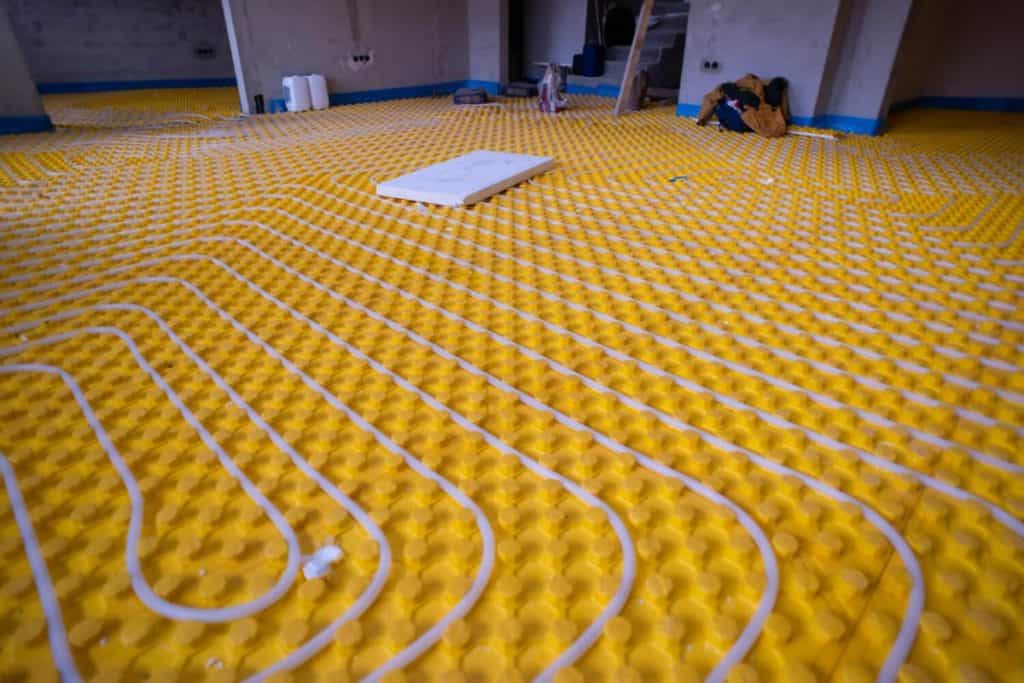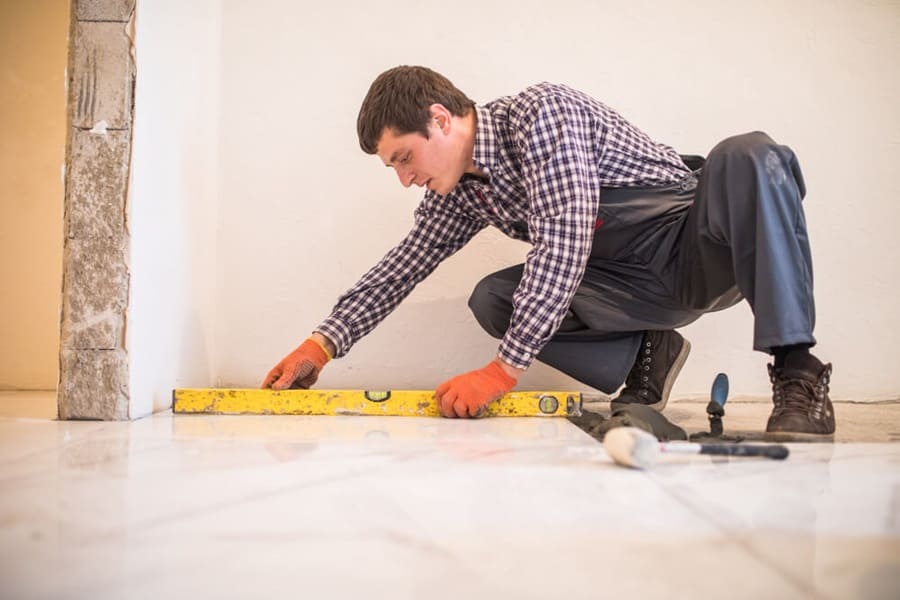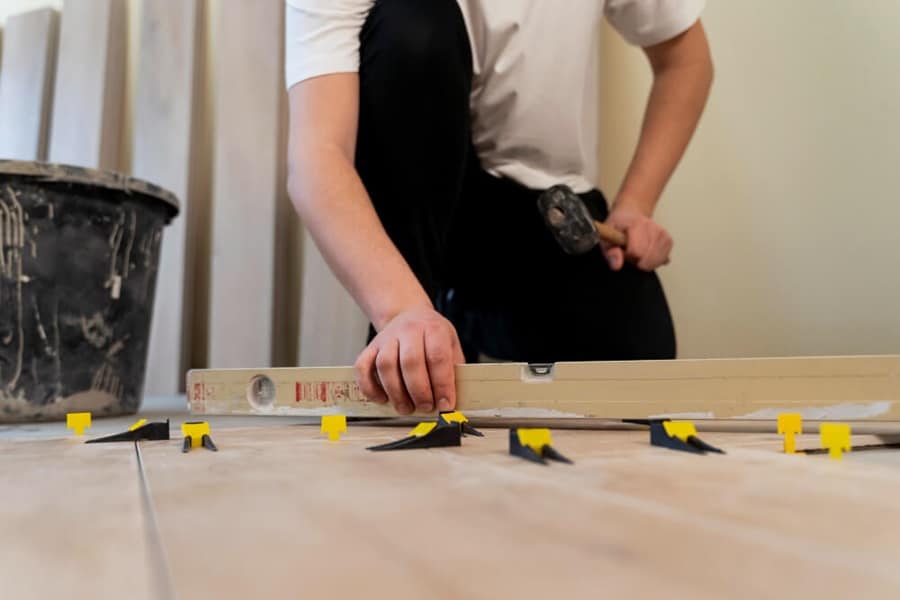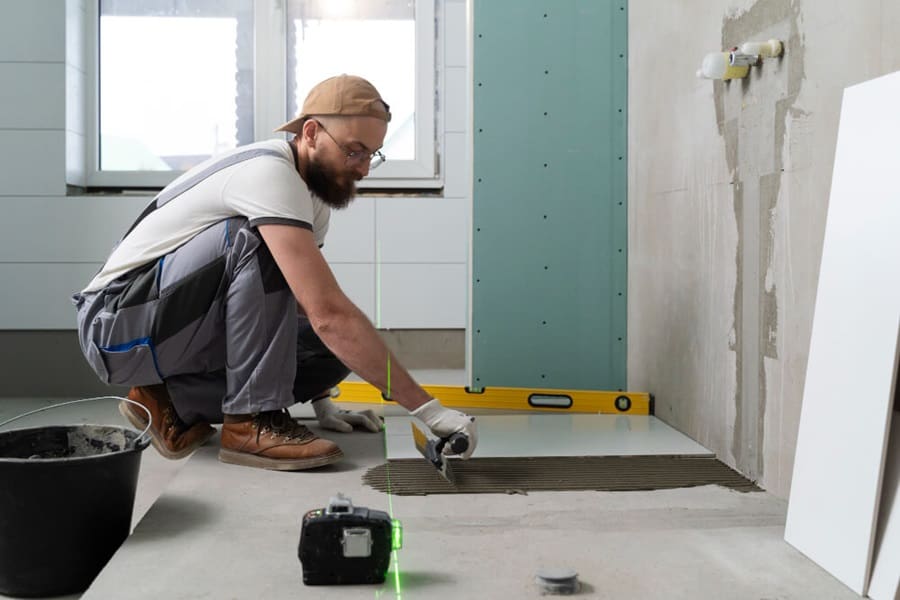
Learn how to efficiently fit underfloor heating mats in your home by learning how to operate them and what size is right for you.
Underfloor heating mats provide a seamless and efficient way to warm your home. You will find these within our electric underfloor heating range. Ideal for various spaces like kitchens and bathrooms, these mats ensure a comfortable temperature underfoot. This article will guide you through measuring your space, selecting the right mat size, and navigating the installation process. With our expert advice, you’ll learn how to achieve the perfect underfloor heating setup, enhancing your living environment with warmth and comfort.
Does underfloor heating add value to new builds? Find out now.
- Tools Needed for Installing Underfloor Heating Mats
- What Size Underfloor Heating Mat Do You Need
- Measuring Underfloor Heating Mats for the Kitchen
- Measuring Underfloor Heating Mat For The Bathroom
- What To Do When The Underfloor Heating Mat Doesn’t Fit
- How to Install Underfloor Heating Mats
- Benefits of Underfloor Heating Mats
Tools Needed for Installing Underfloor Heating Mats
To ensure a smooth installation of underfloor heating mats, you’ll need the following tools:
- Scissors/Cutters: Crucial for adjusting the size of your underfloor heating mat to fit the designated area perfectly.
- Ohmmeter (Multimeter): Helps in checking the electrical resistances, ensuring the heating system functions correctly.
- Chase Cutting Tools: Necessary for creating channels in walls and floors, allowing for proper laying of the mats and connection to the power source.
What Size Underfloor Heating Mat Do You Need
Understanding the area you need to heat is vital before purchasing underfloor heating mats. The size of the mat you select will depend on the dimensions of the space you wish to heat, such as a living room, kitchen, or bathroom. Accurate measurements are key to ensuring you buy an appropriately sized underfloor heating mat.
Measuring Underfloor Heating Mats for the Kitchen

When measuring for an underfloor heating mat in your kitchen, take precise measurements of the length and width of the space. For instance, if your kitchen measures 3.5m x 3.5m, the total area would be 12.25m^2.
However, it’s important to account for any permanent fixtures, like kitchen units, that won’t require heating underneath. If the units cover a 2.1m^2 area, you subtract this from the total to determine the heated area needed. In this example, you would need a mat that covers 10.15m^2.
Selecting the right size of the underfloor heating mat ensures efficient heating and cost-effectiveness. For kitchens, underfloor heating mats provide a consistent warmth, making them a perfect choice for this heart of the home.
View our top tips for having underfloor heating in your kitchen. Knowing this will be particular important if you have porcelain or ceramic tiling.
Measuring Underfloor Heating Mat For The Bathroom

Selecting the correct size underfloor heating mat for your bathroom ensures efficient heating and comfort distribution throughout the room, maximising warmth before and after you’ve had a relaxing shower or bath. Here’s how to determine the right fit for your space.
Step-by-Step Measurement Guide
- Determine the Dimensions: Measure the length and width of your bathroom. For example, if your bathroom is 3 metres long and 2.5 metres wide, the total area is 7.5 square metres (3.0 x 2.5 = 7.5m²).
- Account for Fixed Fixtures: Subtract the area occupied by permanent fixtures like bathtubs or cabinets, as these spaces won’t need heating. If a bathtub measures 70cm by 170cm, its area (0.7 x 1.7 = 1.19m²) should be deducted from the total floor space, reducing the required heating area to 6.31m² (7.50m² – 1.19m²).
- Select the Appropriate Mat Size: With the adjusted area, choose an underfloor heating mat that best fits the space. For our example, a 6m² mat would be ideal for the bathroom.
For installing underfloor heating in your bathroom, read through our list of common underfloor heating FAQs answered.
What To Do When The Underfloor Heating Mat Doesn’t Fit
Not all bathrooms are perfectly rectangular, and standard underfloor heating mats might not always fit irregularly shaped or unusually sized areas. In cases where the available underfloor heating mats don’t meet your specific needs, custom solutions are available. Feel free to contact us today, whereupon we can provide you with bespoke underfloor heating solutions tailored to your bathroom’s unique dimensions and layout, alongside a quote.
The incorrect sized heating mat is only one of numerous common underfloor heating problems you may face.
How to Install Underfloor Heating Mats

Installing underfloor heating mats can transform any room into a warm and inviting space. For our readers that are professional installers, follow these detailed instructions. However, if you are not, do not attempt to perform this task yourself in your home.
Preparing for Installation
- Check the Subfloor: Ensure the sub-floor is dry, clean, and free of dust. It must be suitable for the type of underfloor heating mat you are installing. For wooden subfloors, check stability and reinforce if necessary to prevent flexing. This is essential for installing underfloor heating on timber floors, as well as vinyl.
- Floor Priming: Apply an acrylic primer over the entire area to be heated. Allow it to dry thoroughly, usually taking 1-2 hours, to ensure a good adhesive surface for the mat.
Laying the Heating Mat
- Unbox and Inspect: Carefully unbox the underfloor heating mat, inspecting for any damage to the cables. Testing the mat’s resistance with a multimeter before installation is crucial to avoid future issues.
- Plan the Layout: Review the floor plan and decide where to start laying the mat, usually near the thermostat and power source. Consider the placement of floor sensors for accurate temperature control.
- Install the Mat: Begin at the thermostat, unrolling the mat and pressing it firmly onto the primed subfloor. If the mat has a self-adhesive backing, remove it gradually to secure the mat in place. Use additional tape if necessary, especially around edges and corners.
- Cut and Rotate: When necessary, cut the mesh backing (not the heating cables) to fit the area or change direction. You can rotate the mat or fold it to navigate around obstacles like toilets or cabinetry.
Connecting and Testing
- Electrical Connection: Identify the cold tail (usually a black lead) and prepare it for connection. This may involve separating a braided earth wire in preparation for connecting to the power supply.
- Sensor Installation: Install the floor sensor between heating cables to ensure accurate temperature readings. Place it inside a conduit and then into a pre-cut section of the insulation layer.
- Final Testing: Perform a final check of the mat’s resistance and insulation resistance using a multimeter to ensure everything is in working order.
Finishing Up
- Levelling Compound: If recommended, apply a thin layer of latex-based levelling compound over the cables to protect them during the flooring installation.
- Flooring Installation: Install the final floor covering according to the manufacturer’s instructions and compatibility with underfloor heating. Use a flexible adhesive and grout for tiles to accommodate any movement and prevent cracking.
- Heating System Activation: Gradually increase the temperature over several days to avoid thermal shock to the flooring material. This gradual process helps the adhesive and grout to cure properly, ensuring a long-lasting finish.
By following these steps, you can efficiently install underfloor heating mats, ensuring a warm and comfortable environment in your home. Whether for heated floor mats for bathrooms or underfloor heating mats for larger living spaces, proper installation will result in efficient and effective heating.
To keep your underfloor heating mats secure, follow our guidance which focuses on the best adhesive for underfloor heating.
Benefits of Underfloor Heating Mats
Underfloor heating mats, including heated floor mats for bathrooms and larger areas, offer significant benefits for home heating efficiency and comfort. These benefits include:
- Heat Distribution: The heating wires are evenly spaced, ensuring consistent and uniform heat across the surface.
- Quick Installation: These mats can be installed quickly, often within just a few minutes, due to their user-friendly design.
- Slim Profile: Their low-profile nature means they integrate smoothly with existing floors without significant height increase.
- Dimensions: The mats come in standard sizes, making them perfect for regularly shaped spaces.
- Energy Efficiency: They consume less energy than conventional heating systems, making them a cost-effective choice.
- Versatile Application: Designed to be compatible with various types of projects and flooring materials.
Suitable Underfloor Heating Mats for Floor Finishes
Selecting the suitable underfloor heating mat for your floor finish is crucial for ensuring optimal performance and compatibility. Underfloor heating mats are versatile and can be installed under a wide array of floor finishes, including wood, vinyl, tiles, or carpeting, with the important consideration that the floor covering’s thermal resistance should not exceed 1.5 tog.
For floor finishes like laminate or engineered wood, which are typically floating floors, specific heating mats are designed to provide a stable and effective heating base. If softer floor coverings like carpet are in use, it may be necessary to employ a dual-layer system.
Choose Underfloor Heating Mats for Better Comfort
Heated floor mats for bathrooms and other areas in your home not only offer the luxury of warm floors but also contribute to the overall heating efficiency of your home. By selecting the right size and type of underfloor heating mat, you can enjoy a consistently warm and inviting environment.
Regardless of what area you choose to add your underfloor heating mats too, it is essential to know what to consider before removing carpets.
FAQs
How do you fit underfloor heating mats?
To fit underfloor heating mats, first, prepare the subfloor by cleaning and levelling it. Roll out the heating mats, cut the mesh to fit the room (avoid cutting the wires), and secure the mats to the floor. Connect the mats to the thermostat and power supply, ensuring all electrical connections comply with local regulations.
How do you install a heated floor mat under tile?
To install a heated floor mat under tile, first, lay the mat on the subfloor, ensuring it is flat and covers the area evenly without overlapping. Apply a layer of thin-set mortar over the mat, then place the tiles on top, using spacers to ensure even gaps. Once the mortar is dry, grout between the tiles.
How do you fit a heat mat?
Fit a heat mat by measuring the area, cutting the mat to size (avoiding the wires), and laying it out on the subfloor. Ensure the mat is flat and secure it with adhesive tape or glue. Connect the mat to the thermostat and power supply, following the manufacturer’s instructions.
Are underfloor heating mats expensive to run?
Underfloor heating mats are generally not expensive to run. They are energy-efficient, especially when used with a good insulation layer and a thermostat to control the temperature. The exact running cost will depend on the size of the area, insulation quality, and electricity prices.
Sources
Taylor, G., (2020) 5 Things to Know Before Ripping Up Your Carpeting. BobVila. [online] Available at: https://www.bobvila.com/articles/removing-carpet/ [accessed 14/03/24]
